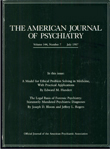PET study of competition between intravenous cocaine and [11C]raclopride at dopamine receptors in human subjects
Abstract
OBJECTIVE: Animal data suggest that the strong euphoriant effects of cocaine are related to the drug's enhancement of available dopamine at the synaptic cleft. The authors' goal was to determine whether this mechanism is the same in humans because the development of putative pharmacological agents for treatment of cocaine dependence depends on this knowledge. METHOD: Positron emission tomography with [11C]raclopride was used to examine the effects of the intravenous administration of 48 mg of cocaine (a typical "street" dose) on the occupancy of dopamine 2 receptors in the putamen of 11 self-identified intravenous drug abusers. RESULTS: All 11 subjects reported subjective stimulation and euphoria in response to cocaine administration. Radioligand occupancy at dopamine receptors was decreased significantly after cocaine administration, suggesting that higher dopamine concentrations were competing at the receptor site. CONCLUSIONS: These results support the concept of dopamine system involvement in human cocaine abuse.



